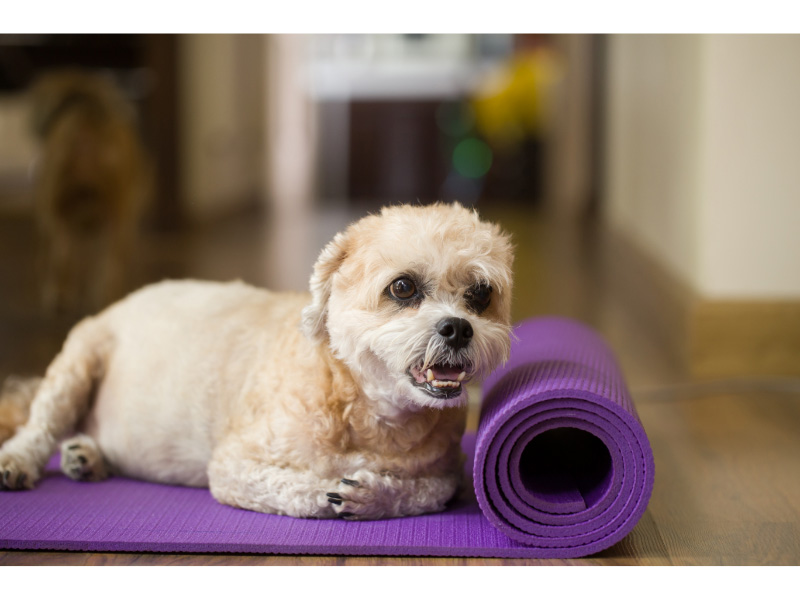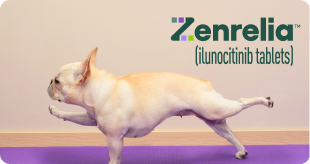
Brr! It’s too cold to go outside, but your pet still has plenty of energy to burn. To keep the zoomies at bay, you can find new ways to help your dog or cat exercise without leaving your warm, comfy home. Here are ten of our favorite ways to keep pets on the move, even when the weather outside is frightful.
10 Ways To Exercise Your Pet In The Wintertime
1. Try nosework or “find it.”
Exercises that encourage your pet to follow their nose are great not only for physical exercise, but for mental stimulation as well. You can search for nosework classes near you, or simply hide healthy pet treats or toys around your home for your pet to find.
2. Teach your pet to jump through hoops.
Jumping is a high-impact exercise that burns more calories in less time than walking or running. A hula hoop, limbo stick, or even a family member can make a great makeshift obstacle. Take care not to overdo it, though, as jumping can cause stress injuries to the joints. Avoid jumping exercises with growing puppies and kittens as well as pets that suffer from arthritis or have a history of muscle or ligament injuries, hip or elbow dysplasia, or other orthopedic issues.
3. Try a treadmill.
Using a treadmill can be a great way to help your pet get some cardio in during the winter, just make sure you’re using it safely. Treadmills should only be used under constant supervision. Your pet should be introduced gradually, while the treadmill is off, and then at the lowest speeds with plenty of positive reinforcement (treats!). If you use a leash, make sure it’s attached to a comfy harness, never a collar to avoid strain on your pet’s neck. If possible, use a made-for-dogs treadmill that’s non-electric and self-propelled, that way the belt will stop when your pet stops. You can also try an exercise wheel for small dogs and cats.
4. Consider swim or water therapy.
Animal physical therapy centers and some vet hospitals have special underwater treadmills for pets. Water therapy reduces the strain on your pet’s joints, making it a great option for disabled and arthritic pets. Some facilities also offer exercise sessions for younger and able-bodied pets.
5. Sign up for doggy daycare.
Doggy daycare can be a great way for sociable dogs to get a few hours of playtime. Some facilities offer day rates or short sessions so your dog can get some exercise in, even if you don’t need daycare services on a regular basis. A reputable facility will make sure your dog has the right temperament for safely playing with other dogs, and will match them up with a playgroup of dogs that are similar in size and personality.
6. Try core and balance workouts.
Cardio isn’t the only way to keep your pet fit and healthy. Core and balance exercises build muscle and improve balance, helping to prevent strain and injury in the future.
7. Play hide-and-seek.
Most pets wouldn’t quite understand the “hide” part of hide-and-seek, but will get a thrill out of finding you and your family members. Have your pet “stay” in one room, or ask a helper to hold them back while you hide. Then, call your pet and watch as they follow your scent and the sound of your voice. You can use treats as a reward and scent cue to help your pet find you.
8. Play monkey-in-the-middle.
This one’s easy: toss a favorite pet toy to a family member and watch your pet run back and forth. To keep your pet motivated, let them catch the toy every now and then.
9. Take to the stairs.
Like jumping, stair-stepping is a high impact exercise that uses a lot of energy in a short amount of time, but it can put a lot of strain on the joints, especially as your pet goes down the stairs, as this action can lead to slips and falls, and also puts extra pressure on their front leg joints. That said, incorporating a stair climb or two into your pet’s exercise session is a great way to get their heart rate up and build up their legs and core. Just be sure to use stairs in moderation, and avoid them if your pet is still growing or is prone to orthopedic issues.
10. Teach your pet to dance.
Doggy dancing or musical freestyle is becoming a popular sport for dogs, and there’s even classes and professional competitions for serious doggy dancers. At home, you can put on your favorite dance music and practice high-energy moves like having your pet spin, weave through your legs, bow, and walk backwards. Your pup’s paw-work need not be complex. You can even use tricks they already know, paired with hand signals to create an easy canine (or kitty!) choreography.











































